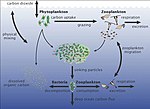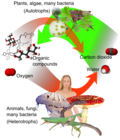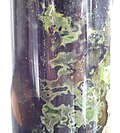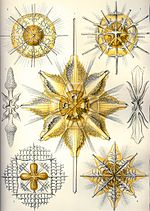A mixotroph is an organism that uses a mix of different sources of energy and carbon, instead of having a single trophic mode, on the continuum from complete...
18 KB (1,692 words) - 06:42, 16 August 2024
Zooplankton (section Mixotrophs)
microplankton have indicated over half of microscopic plankton are mixotrophs. A mixotroph is an organism that can behave sometimes as though it were a plant...
77 KB (7,094 words) - 10:23, 2 June 2024
Marine microorganisms (redirect from Marine mixotroph)
It is estimated that mixotrophs comprise more than half of all microscopic plankton. There are two types of eukaryotic mixotrophs: those with their own...
232 KB (21,388 words) - 09:31, 2 June 2024
"Microbiology of thiobacilli and other sulphur-oxidizing autotrophs, mixotrophs and heterotrophs". Philosophical Transactions of the Royal Society of...
99 KB (11,045 words) - 13:34, 27 August 2024
groups or 'mixotypes' that present different biogeographies: Constitutive mixotrophs, also called 'phytoplankton that eat', have the innate ability to photosynthesize...
94 KB (9,770 words) - 04:46, 23 August 2024
Omnivores (feed on a mixed diet of phyto- and zooplankton and detritus); and Mixotrophs which combine autotrophy (using light energy to grow without intake of...
109 KB (11,576 words) - 06:25, 19 August 2024
While able to perform photosynthesis, many of these eukaryotic groups are mixotrophs and practice heterotrophy to various degrees. Early photosynthetic systems...
109 KB (11,776 words) - 19:45, 6 August 2024
Euglena viridis is a freshwater, single cell, mixotroph microalgae bearing a secondary chloroplast. Their chloroplast is bounded by three layers of membrane...
7 KB (735 words) - 17:27, 12 April 2024
be compatible not only with being an autotroph but also with life as a mixotroph or heterotroph. Weiss et al. 2018 reply that no enzyme defines a trophic...
63 KB (6,628 words) - 06:54, 26 August 2024
Primary nutritional groups (section Mixotrophs)
Primary nutritional groups are groups of organisms, divided in relation to the nutrition mode according to the sources of energy and carbon, needed for...
19 KB (1,636 words) - 13:31, 17 June 2024
Autotrophs Chemosynthesis Chemotrophs Foundation species Kinetotrophs Mixotrophs Myco-heterotrophy Mycotroph Organotrophs Photoheterotrophs Photosynthesis...
128 KB (13,123 words) - 15:10, 23 August 2024
as carbon and energy source by other organisms (e.g. heterotrophs and mixotrophs). The photoautotrophs are the main primary producers, converting the energy...
19 KB (2,043 words) - 08:28, 7 July 2024
it matures within a host's red blood cell. Protozoa may also live as mixotrophs, combining a heterotrophic diet with some form of autotrophy. Some protozoa...
52 KB (5,202 words) - 14:26, 5 August 2024
British Columbia and described in 2012. Rapaza viridis is the first known mixotroph (an organism that combines photosynthesis and ingestion of food) and kleptoplastic...
16 KB (2,305 words) - 02:26, 20 May 2024
hydrogen. Mixotrophs (or facultative chemolithotroph) can use either carbon dioxide or organic carbon as the carbon source, meaning that mixotrophs have the...
28 KB (2,963 words) - 13:47, 23 August 2024
Osmotrophy (section Mixotrophs)
Osmotrophy is a feeding mechanism involving the movement of dissolved organic compounds by osmosis. Organisms that use osmotrophy are called osmotrophs...
4 KB (401 words) - 13:04, 7 August 2024
reverse tricarboxylic acid cycle to perform carbon fixation. They are also mixotrophs and reduce nitrogen. Green sulfur bacteria are gram-negative rod or spherical...
32 KB (3,209 words) - 06:16, 27 April 2024
many have photosynthetic endosymbionts and are, therefore, considered mixotrophs. The skeletal remains of some types of radiolarians make up a large part...
28 KB (2,558 words) - 14:09, 26 June 2024
each other when growing conditions are poor. Mixotrophs are divided into two groups; constitutive mixotrophs, CMs, which are able to perform photosynthesis...
62 KB (6,472 words) - 17:16, 3 August 2024
nutrients from the carbon of inorganic substances like carbon dioxide. Mixotrophs are organisms that can be heterotrophs and autotrophs, including some...
36 KB (4,031 words) - 07:45, 25 July 2024
single-celled alga in the genus Euglena. It has secondary chloroplasts, and is a mixotroph able to feed by photosynthesis or phagocytosis. It has a highly flexible...
10 KB (1,006 words) - 23:13, 20 May 2024
Marine protists (section Mixotrophs)
up" in dead organisms. Mixotrophic radiolarians Mixotrophs have no single trophic mode. A mixotroph is an organism that can use a mix of different sources...
133 KB (10,596 words) - 09:12, 10 July 2024
(Gammaproteobacteria) is a facultative R. pachyptila symbiont and has been shown to be a mixotroph, thereby exploiting both Calvin Benson cycle and reverse TCA cycle (with...
56 KB (6,309 words) - 03:05, 12 May 2024
hemidystrophy, heterotroph, hypertrophy, lithoautotroph, lithotroph, mixotroph, organotroph, phagotrophy, photoheterotroph, phototroph, phototrophic...
2 KB (1,764 words) - 06:15, 16 April 2024
acantharians have photosynthetic endosymbionts and hence are considered mixotrophs. Acantharian skeletons are composed of strontium sulfate, SrSO4, in the...
15 KB (1,655 words) - 19:13, 13 August 2024
are photosynthetically active, but are also heterotrophic. Facultative mixotrophs, in which autotrophy or heterotrophy is sufficient for nutrition, are...
96 KB (10,335 words) - 22:55, 26 August 2024
algae, Cymbomonas tetramitiformis in the order Pyramimonadales, is a mixotroph and able to support itself through both phagotrophy and phototrophy. It...
42 KB (4,163 words) - 17:03, 22 July 2024
Autotrophs Chemosynthesis Chemotrophs Foundation species Kinetotrophs Mixotrophs Myco-heterotrophy Mycotroph Organotrophs Photoheterotrophs Photosynthesis...
31 KB (3,540 words) - 09:27, 13 July 2024
heterotrophic, feeding on bacteria and other small organisms. A few species are mixotrophs, deriving some nutrients from endosymbiotic algae (chlorella) carried...
29 KB (3,057 words) - 00:05, 20 August 2024
to the bed of the water body to overwinter as a turion. The plant is a mixotroph which can produce its own energy by photosynthesis or absorb it from the...
8 KB (858 words) - 04:15, 29 June 2024

























